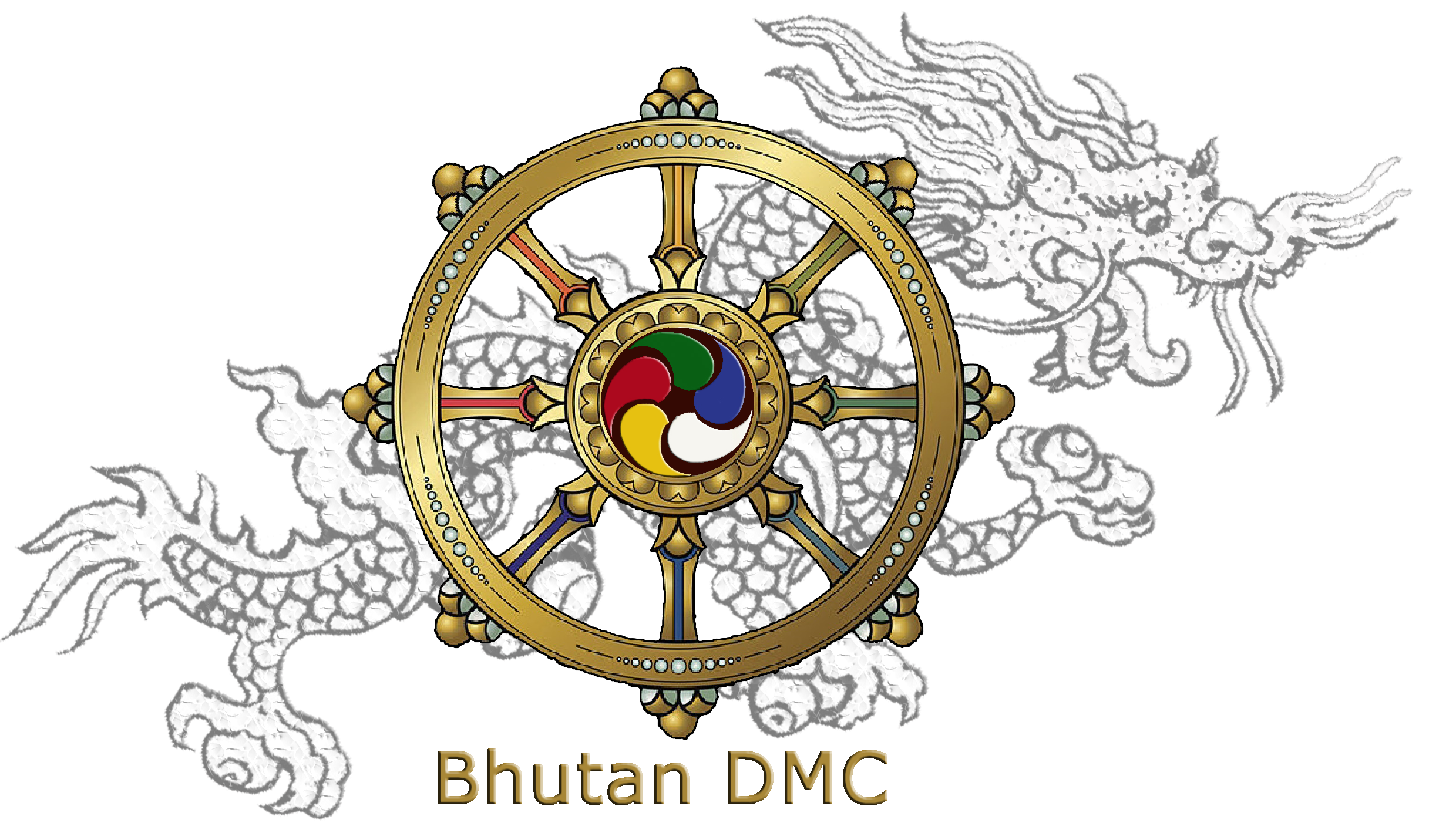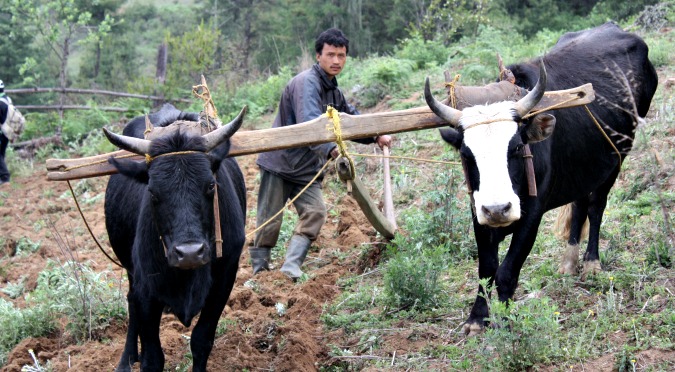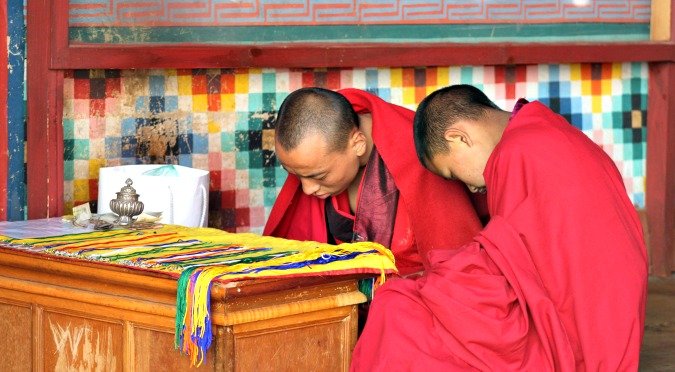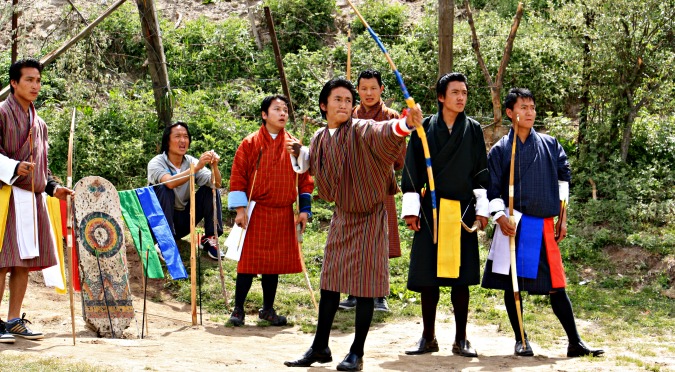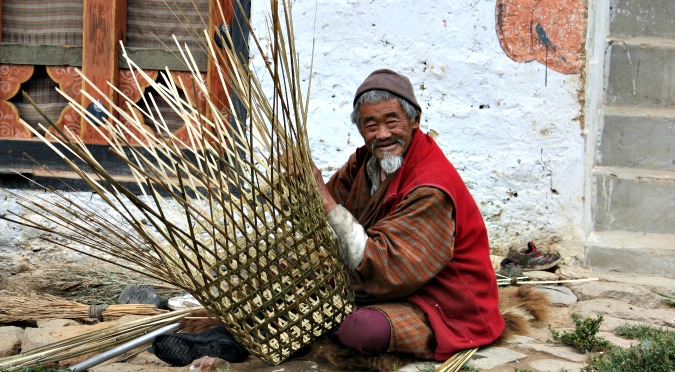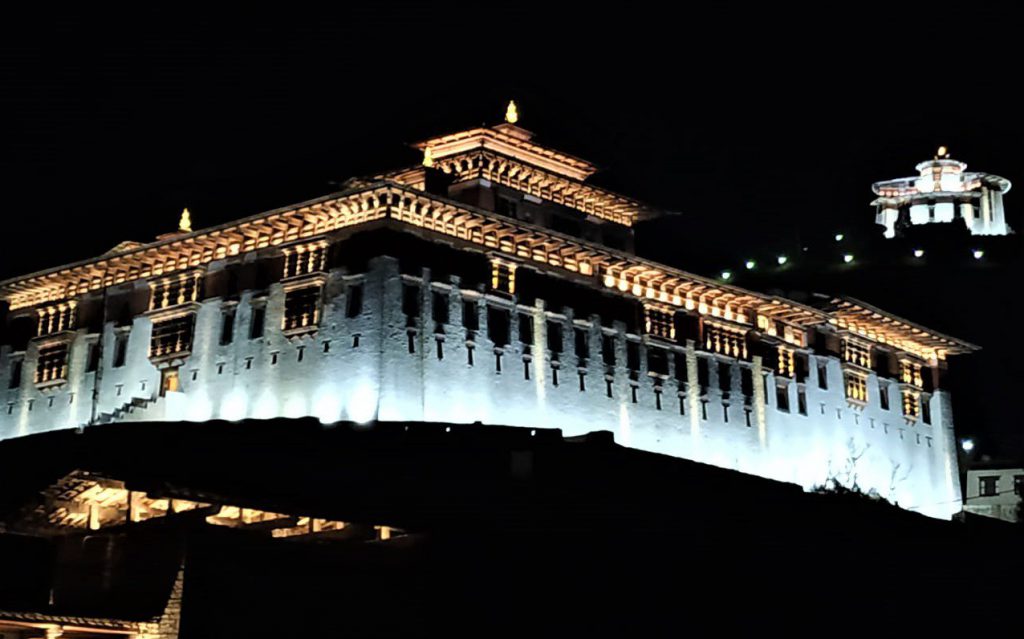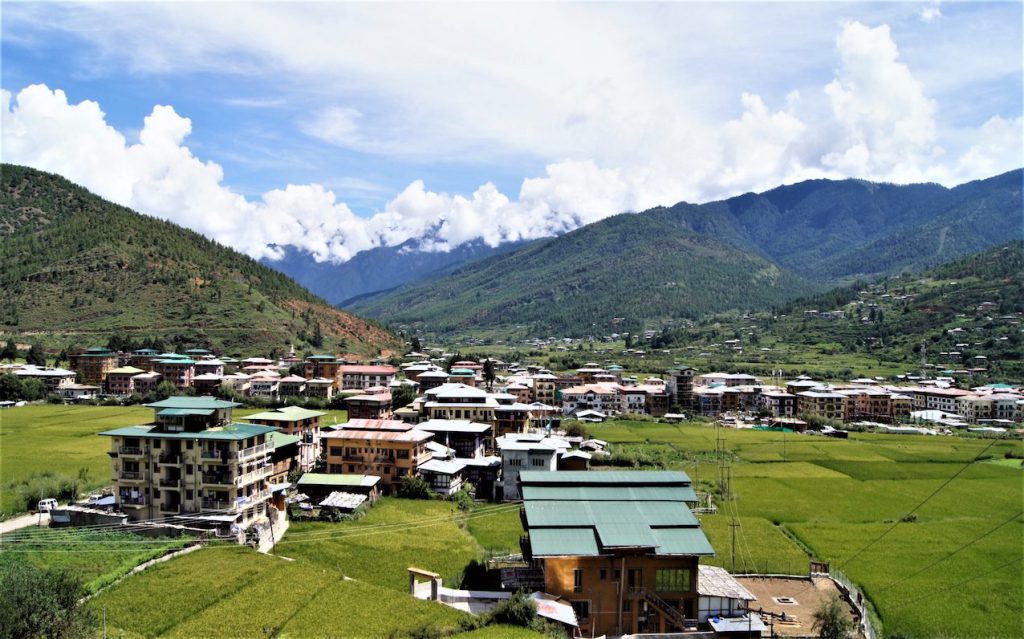Bhutan is magnificent & majestic, a rare combination of harmony and accord, amidst a landscape of incredible natural beauty. Visit to magnificent valleys of Thimphu, Paro and Punakha is indeed a journey into an enchanting realm.
Day 1
Arrive Paro by Flight & Transfer to Thimphu (55 km, approx.1.1/2-hour drive)
The flight to Paro is one of the most spectacular in entire Himalayas. Whether flying along the Himalayan range from Kathmandu or over the foothills from Kolkatta, the journey offers fascinating views and an exciting descent into the Kingdom. Bhutan’s first gift, as you disembark from the aircraft will be cool, clean fresh mountain air. After immigration formalities and baggage collection, you will be met by our representative, and afterwards drive to Thimphu, the capital town of Bhutan with en-route stop at Chuzom, the confluence of Thimphu and Paro rivers. Three different style of stupas; Tibetan, Nepalese and Bhutanese adorn this confluence. Shortly before reaching Chuzom, you will see on your left Tamchog Lhakhang, ‘the temple of the excellent horse’. It is a private temple, built in 15th century, as the result of visitation from Balaha, the excellent horse, a manifestation of Chenrezig, the compassionate Buddha.
On arrival, in Thimphu check-into the hotel. The capital town of Bhutan and the centre of government, religion and commerce, Thimphu is a unique city with unusual mixture of modern development alongside ancient traditions. With the population of about 1,00,000 it is perhaps still the world’s only capital city without a traffic light.
Later in the day take an exploratory walk around local market place located a few minutes’ walk from hotels. Or take a walk to local craft Bazar recently established under patronage of Department of cottage & small industry and in collaboration with the Department of culture, Tourism council and the Department of agriculture marketing and cooperatives. This market offers genuine Bhutanese arts & crafts thus contributing in promotion, protection and preservation of traditional arts.
Evening an exploratory walk around Thimphu main street and market area.
Overnight at the hotel in Thimphu. (Altitude 2,320m)
Day 2
Thimphu
After breakfast, proceed for tour of some of city’s main attractions that includes:
Textile Museum: It is worth a visit to get to know the living national art of weaving. Exhibitions introduce the major weaving techniques, styles of local dress and textiles made by women and men.
National Library: The history of Bhutan lies imprinted in archaic texts, which are preserved at the National Library. Besides thousands of manuscripts and ancient texts, the library also has modern academic books and printing blocks for prayer flags.
Institute for Zorig Chusum: Commonly known as Arts & Crafts School or Painting School, the Institute offers a six-year course on the 13 traditional arts and crafts of Bhutan. On a visit, one can see students learning the various skills taught at the school.
(Zorig Chusum is an art school and are periodically closed for exams, summer and winter holidays, if closed replace visit with Zangtho Pelri Lhakhang)
Zangtho Pelri Lhakhang: The present structure was built in 1960s and although lacking the charm of many of the older temples, Zangtho Pelri still possesses some impressive murals and art treasures and is worthy of a visit. The site of the temple was a former battle ground, and the temple was constructed there in order to pacify energies.
Simply Bhutan Museum: The newly commissioned museum depicts the ancient Bhutanese architecture which is being lost to modernization. The uniqueness of the structure is in its composition of the materials used. The structure is built reusing old timber, window and door frames and other items from traditional and old demolished houses. The best part is the portrayal of the age-old lifestyles of the Bhutanese people.
Lunch followed by city tour that includes:
Memorial Chorten: The stupa built in the memory of Bhutan’s third King, His Late Majesty, King Jigme Dorji Wangchuk, who is popularly regarded as Father of modern Bhutan. The paintings and statues inside the monument provide a deep insight into Buddhist philosophy.
Buddha Point (Kuensel Phodrang): Located at a short drive from Thimphu city centre, visitors can get a good overview of the Thimphu valley from the Buddha point (Kuensel Phodrang). You can pay your obeisance and offer prayers to the Buddha, the largest statue in the country and then walk around and take a glimpse of the valley.
Conclude the tour of the day with a visit of Trashichhoedzong, ‘fortress of the glorious religion’. This is the center of government and religion, site of monarch’s throne room and seat of Je Khenpo or Chief Abbot. Built in 1641 by the political and religious unifier of Bhutan, Shabdrung Ngawang Namgyal, it was reconstructed in 1960s in traditional Bhutanese manner, without nails or architectural plans.
Overnight at the hotel in Thimphu. (Altitude 2,320m)
Day 3
Thimphu – Punakha (75 km, approx. 3-hour drive)
After breakfast at hotel, drive to Punakha across Dochula pass (3,088m/ 10,130 ft) stopping briefly here to take in the view and admire the chorten, mani wall, and prayer flags which decorate the highest point on the road. If skies are clear, the following peaks can be seen from this pass (left to right): Masagang (7,158m), Tsendagang (6,960m), Terigang (7,060m), Jejegangphugang (7,158 m ), Kangphugang (7,170 m ), Zongphugang (7, 060 m ), a table mountain that dominates the isolated region of Lunana – finally Gangkar puensum, the highest peak in Bhutan at 7,497m.
Afternoon visit Punakha Dzong or (Palace of Great Happiness), built at the junction of the Phochu and Mochu rivers in 1637 by Shabdrung Ngawang Namgyal. This majestic dzong served as both the religious and the administrative center of Bhutan in the past. It measures some 600 by 240 feet and has a six-story, gold-domed tower. Inside are courtyards and religious statuary that hint at the depth of history and spiritual tradition embodied here. Your guide will illuminate your understanding of this intricate culture that is exotic to us, though long established here.
Afterwards proceed for walking excursion to Chimi Lhakhang.
The Chimi Lhakhang, situated on a hillock in the centre of the valley, also known as the temple of fertility. It is widely believed that couples who do not have children and wanting one, if they pray at this temple, they are usually blessed with a child very soon.
Evening explore Wangduephodrang town and its market area.
Overnight at the hotel in Punakha. (Altitude 1,300m)
Day 4
Punakha – Paro (125 km, approx. 4-hour drive)
Morning after breakfast, drive back to Paro descending back down from Dochu La, follow the way back up the dramatic Wang Chhu and Paro Chhu river valleys, before crossing through Paro Town towards the north end of the valley.
En route visit Simtokha Dzong, the place of profound tantric teaching, this dzong now houses a school for the study of the Dzongkha language.
Later in the day after checking into hotel, proceed to visit Ta Dzong, originally built as Watchtower, which now houses National Museum. The extensive collection includes antique thangkha paintings, textiles, weapons & armour, household objects and a rich assortment of natural and historic artifacts.
Then walk down the trail to visit Rinpung Dzong, meaning (‘fortress of the heap of jewels’), which has a long and fascinating history. Along the wooden galleries lining the inner courtyard are fine wall paintings illustrating Buddhist lore such as four friends, the old man of long life, the wheel of life, scenes from the life of Milarepa, Mount. Sumeru and other cosmic Mandala.
Later take a stroll around Paro city centre and market.
Overnight at the hotel in Paro. (Altitude 2,280m)
Day 5
Paro
After breakfast excursion to Taktshang Monastery (Tiger’s Nest): It is one of the most famous of Bhutan’s monasteries, perched on the side of a cliff 900m above the Paro valley floor. It is said that Guru Rinpoche arrived here on the back of a tigress and meditated at this monastery and hence it is called ‘Tiger’s Nest’. This site has been recognized as a most sacred place and visited by Shabdrung Ngawang Namgyal in 1646 and now visited by all Bhutanese at least once in their lifetime.
On the way back to Paro town, stop at the base of Drukgyel Dzong, a ruined fortress currently under restoration, where Bhutanese warriors fought Tibetan invaders centuries ago. The snowy dome of sacred Chomolhari, ‘mountain of goddess’ can be seen in all her glory from the approach road to the Dzong.
Along the way to town, visit the 7th century Kyichu Lhakhang, one of the 108 temples built in the Himalayas by Tibetan King, Songtsen Gampo. The building of this temple marks the introduction of Buddhism in Bhutan.
Evening at leisure in Paro market.
Overnight at the hotel in Paro. (Altitude 2,280m)
Day 6
Depart Paro
After breakfast at the hotel, drive to the airport for flight to your onward destination. Our representative will help you with exit formalities and then bid you farewell.
Image Gallery
